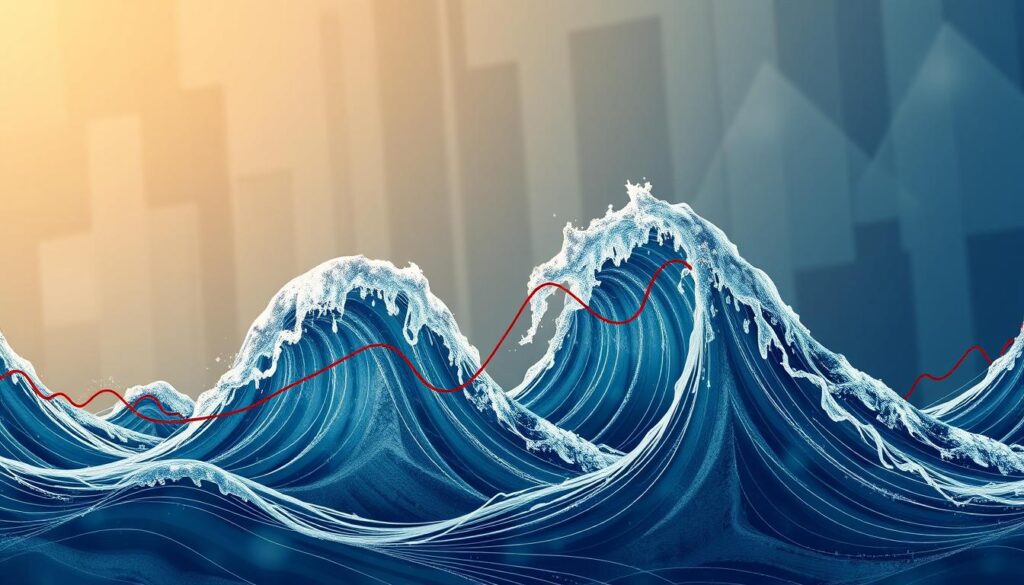Elliott Wave Theory, developed by Ralph Nelson Elliott, is a popular technical analysis tool used for stock market forecast. This theory is based on the idea that market prices fluctuate between impulsive and corrective phases, which can be used to predict future price movements. By applying Elliott Wave Theory, traders can gain a better understanding of market trends and make more informed investment decisions. For those interested in learning more about investing in cryptocurrency, visit technical analysis resources.
Elliott Wave Theory has been widely used by traders and investors to analyze market trends and predict future price movements. The theory is based on the idea that market prices move in waves, with each wave consisting of five sub-waves. By analyzing these waves, traders can identify trends and make more informed investment decisions. Elliott Wave Theory is a powerful tool for stock market forecast and technical analysis.
Table of Contents
Key Takeaways
- Elliott Wave Theory is a technical analysis tool used for stock market forecast.
- The theory is based on the idea that market prices fluctuate between impulsive and corrective phases.
- Elliott Wave Theory can be used to predict future price movements and identify trends.
- The theory is widely used by traders and investors to analyze market trends.
- Elliott Wave Theory is a powerful tool for technical analysis and stock market forecast.
Understanding the Basics of Elliott Wave Theory
Ralph Nelson Elliott, the father of the Elliott Wave Theory, developed this concept after studying 75 years of stock market behavior. His work, “The Wave Principle,” published in 1938, introduced the idea that market movements can be predicted by identifying repetitive wave-like patterns driven by investor sentiment. These patterns reflect market psychology and can be used for trend analysis.
The Elliott Wave Principle identifies mass psychology swings in a natural sequence in specific and measurable patterns, known as wave patterns. This theory suggests that stock price movements can be predicted by studying these patterns, which consist of impulsive waves and corrective waves. Impulsive waves are composed of five subwaves, while corrective waves are divided into three subwaves.
The core principles of wave patterns are based on the idea that markets move in repetitive cycles, driven by investor sentiment. These cycles can be used to identify potential reversal points and predict future market movements. By applying the Elliott Wave Principle, traders and investors can make more informed decisions and increase their profit opportunities. The theory is widely used by thousands of institutional portfolio managers, traders, and private investors, and is considered a reliable tool for trend analysis and understanding market psychology.
Origins and Development of Elliott Wave Theory
Elliott Wave Theory was developed in the 1930s by Ralph Nelson Elliott, who recognized repeating cycles in financial markets reflecting investor moods. His work built on the Dow Theory, which also defines price movement in terms of waves. However, Elliott’s theory introduced the concept of fractal patterns in market movements, which is a key aspect of the Elliott Wave Principle.
Core Principles of Wave Patterns
The Elliott Wave Principle is based on the idea that markets move in repetitive cycles, driven by investor sentiment. These cycles consist of impulsive waves and corrective waves, which can be used to identify potential reversal points and predict future market movements. The theory also uses Fibonacci ratios to determine levels of support and resistance in the markets.
The Psychology Behind Market Waves
The psychology behind market waves is a key aspect of the Elliott Wave Theory. The theory suggests that market movements are driven by investor sentiment, which can be measured by identifying repetitive wave-like patterns. By understanding these patterns, traders and investors can gain insight into market psychology and make more informed decisions.
The Five-Wave Impulse Pattern in Stock Markets
The five-wave impulse pattern is a fundamental concept in Elliott Wave Theory, where market prices alternate between an impulsive, or motive phase, and a corrective phase on all time scales of trend. Impulses are always subdivided into a set of 5 lower-degree waves, which move in the direction of the larger trend direction. This pattern is characterized by five sub-waves, typically labeled as Wave 1, Wave 2, Wave 3, Wave 4, and Wave 5.
These impulse waves are also known as motive waves, as they are driven by the underlying market trend. The typical behavior of each wave within the impulse pattern includes their relative strengths and retracements. For example, Wave 2 usually retraces between 38%-78% of the distance covered by Wave 1, with the typical retracement being close to the 61.8% mark.
- Wave 2 should not retrace more than 100% of Wave 1
- Wave 3 should not be the shortest among waves 1, 3, and 5
- Wave 4 should not overlap with Wave 1
These rules help traders identify and analyze the impulse wave patterns, which can be used to predict larger price movements in the equity market.
Understanding the five-wave impulse pattern is essential for traders who want to apply Elliott Wave Theory in their trading strategies. By recognizing the characteristics of each wave, traders can make informed decisions about when to enter or exit a trade, and how to manage their risk.
Corrective Waves and Their Significance
Corrective waves play a crucial role in understanding market dynamics, particularly in the context of wave analysis. These waves occur against the trend of the larger degree, providing valuable insights into potential market reversals. The significance of corrective waves lies in their ability to help traders identify areas of support and resistance, ultimately informing their trading strategies.
In the realm of market corrections, corrective waves can be categorized into distinct types, including zigzags, flats, and triangles. Each type of corrective wave has its unique characteristics, such as the number of sub-waves and the extent of price movement. By recognizing these patterns, traders can better navigate the complexities of the market, making more informed decisions about when to enter or exit a trade.
Types of Corrective Waves
- Zigzag corrective waves: characterized by a sharp and swift price movement
- Flat corrective waves: typically involve a more gradual price movement
- Triangle corrective waves: often associated with a period of consolidation before the main trend resumes
Corrective waves can exhibit Fibonacci retracement levels, such as 38.2%, 50%, and 61.8%, which can act as support or resistance levels for price movements. By incorporating wave analysis into their trading strategies, traders can gain a deeper understanding of market sentiment, trend reversals, and market dynamics, ultimately leading to more effective trading strategies and better market corrections.
Wave Counting Techniques for Beginners
To master Elliott Wave counting, it’s essential to understand the different degrees of waves and how to identify them on charts. Elliott Wave Theory suggests that financial markets move in a series of waves, consisting of five impulse waves and three corrective waves in an entire market cycle. The key to successful wave counting lies in chart analysis and wave identification.
Beginners can start by analyzing the Grand Super Cycle degree, usually found in weekly and monthly time frames, and then move down to lower degrees, such as the Subminuette degree, found in the hourly time frame. Here are some tips for improving wave counting accuracy:
- Start with a clear understanding of the Elliott Wave Theory and its principles
- Practice wave identification on different time frames and charts
- Use chart analysis tools, such as Fibonacci retracement levels, to identify potential reversal points
By following these steps and dedicating time to practice, beginners can develop their Elliott Wave counting skills and improve their market predictions. Remember to always consider multiple time frames and use chart analysis to confirm your wave counts.
With patience and persistence, anyone can become proficient in wave identification and chart analysis, leading to more accurate market predictions and better trading decisions.
| Wave Degree | Time Frame |
|---|---|
| Grand Super Cycle | Weekly, Monthly |
| Subminuette | Hourly |
Elliott Waves for Stock Market Prediction: Essential Tools and Methods
To effectively apply Elliott Wave Theory, traders need to utilize various technical indicators, trading platforms, and chart patterns. Technical indicators such as oscillators and momentum indicators can help identify wave patterns and provide confirmation for trade decisions.
Popular trading platforms like MetaTrader and TradingView offer a range of tools and features that can be used to analyze and trade Elliott Waves. These platforms provide real-time market data, charting tools, and technical indicators that can be used to identify wave patterns and make informed trade decisions.
Technical Analysis Tools
Technical analysis tools such as trendlines, Fibonacci levels, and chart patterns can be used to identify wave patterns and predict market movements. Trendlines can be used to visualize market sentiment and provide dynamic support and resistance levels, while Fibonacci levels can be used to identify reversal points and optimal entry and exit points.
Software and Platforms
Software and platforms like TradeDots offer a range of tools and features that can be used to analyze and trade Elliott Waves. These platforms provide real-time market data, charting tools, and technical indicators that can be used to identify wave patterns and make informed trade decisions.
By utilizing these essential tools and methods, traders can improve their ability to predict stock market movements and make informed trade decisions. Whether you are a beginner or an experienced trader, understanding how to use technical indicators, trading platforms, and chart patterns can help you to achieve success in the markets.
Understanding Market Cycles Through Wave Theory
Market cycles are a crucial aspect of understanding the overall trend and direction of the market. By analyzing these cycles, investors can make informed decisions about their investments. The Elliott Wave Theory, developed by Ralph Nelson Elliott, provides a framework for understanding these market cycles and long-term trends. This theory suggests that market behavior moves in waves that form repetitive patterns between bullish and bearish sentiments.
The concept of cyclical analysis is essential in understanding market cycles. It involves analyzing the patterns and trends in the market to predict future movements. By identifying the different stages of the market cycle, investors can adjust their investment strategies accordingly. The Elliott Wave Theory provides a useful tool for cyclical analysis, as it helps investors identify the different waves and patterns in the market.
Some key points to consider when using the Elliott Wave Theory for market cycle analysis include:
- Identifying the overall trend and direction of the market
- Analyzing the different waves and patterns in the market
- Using cyclical analysis to predict future movements
By understanding market cycles and long-term trends through the Elliott Wave Theory, investors can make more informed decisions about their investments. This theory provides a valuable tool for cyclical analysis and can help investors navigate the complexities of the market.
Combining Elliott Waves with Other Technical Indicators
Technical analysis is a crucial aspect of trading, and combining Elliott Waves with other technical indicators can enhance its effectiveness. By integrating Elliott Waves with tools like Fibonacci retracements, RSI, MACD, and volume analysis, traders can make more informed decisions. This approach allows for a more comprehensive understanding of market trends and patterns.
For instance, Fibonacci retracement can be used to identify potential reversal areas, while RSI and MACD integration can provide insights into market momentum and trends. Volume analysis can also be used to confirm wave counts and identify potential breakouts. By combining these technical indicators, traders can develop a more robust trading strategy that takes into account multiple market factors.
Some key benefits of combining Elliott Waves with other technical indicators include:
- Improved accuracy in identifying market trends and patterns
- Enhanced risk management through more informed decision-making
- Increased confidence in trading decisions through a more comprehensive understanding of market analysis
By incorporating technical analysis and trading indicators into their strategy, traders can gain a competitive edge in the market. As market trends continue to evolve, it’s essential to stay informed and adapt to new developments. By combining Elliott Waves with other technical indicators, traders can stay ahead of the curve and make more informed decisions.
| Technical Indicator | Description |
|---|---|
| Fibonacci Retracement | Identifies potential reversal areas |
| RSI and MACD Integration | Provides insights into market momentum and trends |
| Volume Analysis | Confirms wave counts and identifies potential breakouts |
Common Wave Pattern Variations
In the world of Elliott Wave Theory, wave structures don’t always follow the standard rules. While the traditional 5-wave impulse pattern is well-known, market patterns can vary, and understanding these variations is crucial for accurate pattern recognition. In reality, a 3-wave move happens more frequently in the market than a 5-wave move, making it essential to recognize these differences.
Some common variations include extended waves, truncated fifths, and diagonal triangles. These wave structures can be challenging to identify, but they offer valuable insights into market patterns. By recognizing these variations, traders can improve their pattern recognition skills and make more informed decisions.
Here are some key points to consider when analyzing wave structures:
- Impulse waves consist of three motive waves and two corrective waves, representing a 5-3-5-3-5 structure.
- Corrective waves can be either sharp corrections with steep movements or sideways corrections that appear flat before ending.
- Diagonal waves have five sub-waves and resemble a wedge shape, either expanding or contracting.
By understanding these variations and applying pattern recognition techniques, traders can gain a deeper insight into market patterns and make more accurate predictions. Whether you’re a seasoned trader or just starting out, recognizing common wave pattern variations is essential for success in the world of Elliott Wave Theory.
| Wave Type | Structure | Description |
|---|---|---|
| Impulse Wave | 5-3-5-3-5 | Three motive waves and two corrective waves |
| Corrective Wave | 3-3-5 | Sharp or sideways correction |
| Diagonal Wave | 3-3-3-3-3 | Five sub-waves, expanding or contracting |
Risk Management Strategies in Wave Trading
Effective risk management is crucial in any trading strategy, including Elliott Wave trading. To minimize losses, traders must employ strong risk management tactics, such as setting stop-loss orders and handling wave extensions. A key aspect of risk management is trading psychology, which involves managing emotions and making informed decisions.
A well-structured portfolio strategy is also essential for managing risk. This involves diversifying investments and allocating resources effectively. By combining Elliott Wave analysis with other technical indicators, traders can make more informed decisions and minimize potential losses. Some key considerations for risk management include:
- Setting stop-loss orders to automatically exit positions
- Handling wave extensions and complex corrections
- Maintaining discipline and managing emotions
By incorporating these risk management strategies into their trading plan, traders can better navigate the markets and achieve their goals. Risk management is an ongoing process that requires continuous monitoring and adjustment. As traders gain more experience and insight into the markets, they can refine their risk management strategies and improve their overall performance.
Ultimately, a successful trading strategy depends on a combination of technical analysis, trading psychology, and effective portfolio strategy. By mastering these elements and staying focused on their goals, traders can achieve success in the markets and minimize potential losses.
| Risk Management Strategy | Description |
|---|---|
| Stop-Loss Orders | Automatically exit positions to minimize losses |
| Wave Extensions | Handle complex corrections and wave extensions |
| Discipline and Emotions | Maintain discipline and manage emotions to make informed decisions |
Advanced Wave Analysis Techniques
For traders looking to deepen their understanding of market trends, advanced wave analysis techniques offer a comprehensive approach to market forecasting. By examining complex corrections and understanding the concept of wave degree, traders can make more accurate predictions about future market movements.
Elliott identified nine degrees of waves, which he labeled from largest to smallest. This understanding of wave degrees is crucial for traders, as it allows them to analyze waves of different degrees and make informed decisions about their trading strategies. Learning about wave analysis can help traders improve their skills and achieve better results.
Some key points to consider when using advanced wave analysis techniques include:
* Analyzing multiple time frames to identify patterns and trends
* Understanding the concept of alternate wave counts and its importance in analysis
* Using wave analysis in combination with other technical indicators to enhance trading efficacy
Real-World Examples of Successful Wave Trading
Trading success stories often involve a combination of technical analysis and market analysis. One such example is the analysis of Mandhana Retail Ventures Ltd, an Indian company. By identifying the end of wave 1 and wave 2 from a significant high, traders can make informed decisions about their trading success stories.
A key aspect of market analysis is the practical application of Elliott Wave Theory. This involves analyzing historical market movements and identifying patterns such as impulse waves. Impulse waves consist of five waves: two corrective waves and three motive waves. Wave 3 is typically the longest and most emphatic of the five impulsive waves.
Case Studies
In the case of Mandhana Retail Ventures Ltd, the analysis included identifying the end of wave 1 and wave 2 from a significant high. The trade discussed lasted about 12 days, during which a profit of about 17% was made. This demonstrates the potential of trading success stories when combined with thorough market analysis and practical application of Elliott Wave Theory.
Market Analysis Examples
Market analysis is crucial in identifying trading opportunities. For example, a fourth wave recovered to the 38.2% retracement level of wave 3, and wave 5 was observed to have ended precisely as predicted in the analysis. This highlights the importance of volume and momentum in determining the end of wave 3.
Trading Scenarios
Traders often capitalize on market momentum by entering after wave 3, which is usually the longest and strongest wave in the pattern. Fibonacci extensions can help traders estimate profit targets based on the possible length of waves 3 or 5. By combining these tools with thorough market analysis, traders can increase their chances of trading success stories.
| Wave Pattern | Description |
|---|---|
| Impulse Wave | Consists of five waves: two corrective waves and three motive waves |
| Corrective Wave | Recovers to the 38.2% retracement level of wave 3 |
| Motive Wave | Wave 3 is typically the longest and most emphatic of the five impulsive waves |
Avoiding Common Elliott Wave Analysis Mistakes
To improve accuracy in Elliott Wave analysis, it’s essential to recognize common wave counting errors and analysis pitfalls. Many traders make the mistake of trying to force markets into perfect patterns, rather than letting the market dictate the counts. This approach can lead to inaccurate predictions and significant losses.
Some common mistakes include ignoring alternate scenarios and failing to adapt to changing market conditions. Improving accuracy requires a deep understanding of market psychology and wave patterns, as well as the ability to validate wave counts and seek confluence between wave counts and timeframes. Traders should also be aware of the importance of trend alignment, risk management, patience, and discipline in successful Elliott Wave trading.
Key considerations for avoiding common mistakes include:
- Avoiding the temptation to force wave counts
- Considering alternate scenarios and adapting to changing market conditions
- Validating wave counts and seeking confluence between wave counts and timeframes
- Emphasizing trend alignment, risk management, patience, and discipline
By being aware of these common pitfalls and taking steps to avoid them, traders can improve their accuracy and achieve greater success in their Elliott Wave analysis.
| Common Mistake | Best Practice |
|---|---|
| Forcing wave counts | Let the market dictate the counts |
| Ignoring alternate scenarios | Consider alternate scenarios and adapt to changing market conditions |
| Failing to validate wave counts | Validate wave counts and seek confluence between wave counts and timeframes |
Building Your Wave Trading Strategy
To develop a successful wave trading strategy, it’s essential to create a trading plan that incorporates strategy development and continuous performance analysis. This plan should outline your goals, risk tolerance, and the specific wave patterns you’ll focus on. By sticking to a well-defined plan, you can avoid the common pitfall of hopping between different strategies and instead become a specialist in one area.
A key component of your trading plan is backtesting methods, which allow you to evaluate the effectiveness of your strategy using historical data. This process helps you refine your approach and identify potential weaknesses. Additionally, performance monitoring is crucial for tracking your progress and making adjustments as needed.
Some key considerations for building your wave trading strategy include:
- Defining your trading goals and risk tolerance
- Developing a comprehensive trading plan that incorporates wave analysis
- Implementing backtesting methods to evaluate strategy effectiveness
- Continuously monitoring and analyzing performance to refine your approach
By following these steps and maintaining a disciplined approach, you can develop a successful wave trading strategy that helps you achieve your goals in the market.
| Strategy Component | Description |
|---|---|
| Trading Plan | Outlines goals, risk tolerance, and wave patterns to focus on |
| Backtesting Methods | Evaluates strategy effectiveness using historical data |
| Performance Monitoring | Tracks progress and identifies areas for improvement |
Time Frames and Wave Analysis
When applying Elliott Wave theory, time frames play a crucial role in understanding market trends. The theory itself does not specify the duration of each wave, leaving traders to determine whether a pattern will complete in days, weeks, or years. This ambiguity highlights the importance of multi-timeframe analysis in wave identification.
To effectively use wave analysis, traders must consider different trading horizons, from intraday charts to long-term market cycles. By examining waves across various time frames, traders can better understand the fractal nature of market movements and identify patterns that may not be visible on a single time frame. This approach allows for a more comprehensive understanding of market trends and enables traders to make more informed decisions.
Some key considerations for multi-timeframe analysis include:
- Aligning wave counts across different time frames to ensure consistency
- Identifying patterns that repeat at different degrees, such as fractals
- Using wave identification techniques to determine the likelihood of a wave completing in a specific time frame
By incorporating multi-timeframe analysis into their wave analysis, traders can gain a deeper understanding of market trends and make more accurate predictions. This approach can help traders to better navigate different trading horizons and improve their overall trading performance.
Psychology of Wave Trading Success
Successful trading is as much about psychology as it is about analysis. To achieve success in wave trading, it’s essential to understand the psychological aspects that influence trading decisions. Developing emotional intelligence and disciplined trading habits are crucial for maintaining a resilient trading mindset.
A key aspect of wave trading psychology is emotional control. This involves managing emotions such as fear, greed, and anxiety, which can cloud judgment and lead to impulsive decisions. By cultivating emotional control, traders can make more informed decisions and avoid common pitfalls.
Decision-Making Process
The decision-making process in wave trading involves a combination of technical analysis and psychological discipline. Traders must be able to analyze wave patterns, identify potential trading opportunities, and make decisions based on their analysis. This requires a deep understanding of trading psychology and the ability to manage emotions and biases.
Building Trading Discipline
Building trading discipline is essential for long-term success in wave trading. This involves developing a trading plan, setting clear goals and risk management strategies, and sticking to them. By cultivating disciplined trading habits, traders can avoid common mistakes and achieve more consistent results.
Some key strategies for building trading discipline include:
- Developing a trading plan and sticking to it
- Setting clear goals and risk management strategies
- Practicing emotional control and managing biases
- Continuously learning and improving trading skills
By incorporating these strategies into their trading routine, traders can develop the psychological discipline and emotional intelligence needed to succeed in wave trading.
| Strategy | Description |
|---|---|
| Emotional Control | Managing emotions to make informed decisions |
| Disciplined Trading | Developing a trading plan and sticking to it |
| Trading Psychology | Understanding the psychological aspects of trading |
Conclusion
As we conclude this comprehensive guide on using Elliott Wave Theory for stock market prediction, it’s clear that this time-tested approach offers valuable insights for savvy traders. By understanding the Elliott Wave mastery, you can uncover the hidden patterns and psychology that drive market movements, enabling you to make more informed trading decisions.
Effective Elliott Wave analysis requires a commitment to continuous learning and dedicated practice. The more you immerse yourself in studying market behavior, the better you’ll become at identifying wave patterns and anticipating future trends. Remember, this is a journey, not a destination, and the more you apply these principles, the more you’ll develop a keen eye for market insights.
Whether you’re a seasoned trader or just starting your journey, the power of Elliott Wave Theory lies in its ability to provide a structured framework for understanding market cycles. By combining this approach with other technical indicators and risk management strategies, you can position yourself to navigate the financial markets with greater confidence and success.
As you continue to explore and apply the concepts presented in this guide, remember to remain patient, adaptable, and open to learning. The financial markets are ever-evolving, and the true mastery of Elliott Wave analysis comes from a willingness to continuously refine your skills and stay ahead of the curve.
FAQ
What is Elliott Wave Theory?
Elliott Wave Theory is a method of stock market prediction that analyzes market psychology and identifies recurring wave patterns in price movements.
How did Elliott Wave Theory originate?
Elliott Wave Theory was developed by Ralph Nelson Elliott, who observed that market movements follow predictable patterns based on human psychology and the principles of the Dow Theory.
What are the core principles of Elliott Wave Theory?
The core principles of Elliott Wave Theory include the concept of fractal patterns, the 5-3 wave structure, and the idea that market movements reflect the psychology of investors.
What is the five-wave impulse pattern?
The five-wave impulse pattern is a fundamental component of Elliott Wave Theory, where the market moves in a five-wave sequence in the direction of the larger trend.
How do corrective waves differ from impulse waves?
Corrective waves occur against the direction of the larger trend, and they include different types of patterns such as zigzags, flats, and triangles.
Why is wave counting important in Elliott Wave analysis?
Accurately counting the waves is crucial for identifying the current market structure and predicting future price movements based on Elliott Wave Theory.
What technical tools are used in conjunction with Elliott Wave analysis?
Elliott Wave analysis can be enhanced by incorporating other technical indicators, such as Fibonacci retracements, RSI, MACD, and volume analysis.
How can Elliott Wave Theory be used to understand market cycles?
Elliott Wave Theory provides a framework for understanding the broader market cycles, from short-term fluctuations to long-term trends, by identifying the nested waves within the larger market structure.
What are some common variations in Elliott Wave patterns?
Elliott Wave patterns can sometimes exhibit variations, such as extended waves, truncated fifths, and diagonal triangles, which require additional analysis to interpret accurately.
How can traders manage risk when using Elliott Wave analysis?
Effective risk management strategies for Elliott Wave traders include setting appropriate stop losses, proper position sizing, and diversifying a portfolio based on wave analysis.









